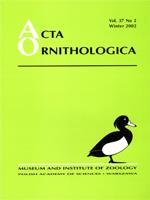Migratory Red-backed Shrikes were mist-netted during the spring and autumn migrations (n = 1031 individuals) from 1984 to 2001 in Eilat (Israel). In a similar pattern of trapping, more than four times as many shrikes were caught during autumn than in spring. Males migrated significantly earlier than females in spring but not during the autumn migration, which suggests that in males there is a stronger drive to reach their breeding territories early. In both seasons and between both sexes we did not find any significant relations between the body measurements of individuals and the time of passage. The spring migration was much shorter time than the autumn migration. This was expressed by the minimum stopover duration, as well as by the time when Red-backed Shrike occurred in Eilat. There are significant differences between wing chord length, body mass and fat scores between seasons. In autumn males had longer wings, and both sexes were heavier and in better condition than in spring. The data suggest that the differences are an adaptation to their having to cross the Sahara Desert. The birds spend a statistically significantly shorter period of time at the Eilat stopover site in spring than in autumn (median 1 ± 1.5 days vs 5 ± 6.5 days). In autumn, recaptured birds were 6.3% heavier than during the first capture. The change in body mass was significantly correlated to the duration of the stopover period. The results suggest that migration over desert is energetically costly and that Eilat is a very important stopover site for migrating Red-backed Shrikes.
BioOne.org will be down briefly for maintenance on 14 May 2025 between 18:00-22:00 Pacific Time US. We apologize for any inconvenience.
How to translate text using browser tools
1 December 2002
Differences Between the Spring and Autumn Migration of the Red-Backed Shrike Lanius collurio: Record from the Eilat Stopover (Israel)
Piotr Tryjanowski,
Reuven Yosef
R. V. Alatalo,
L. Gustafsson,
A. Lundberg
1984. Why do young passerine birds have shorter wings than older birds? Ibis 126: 410–415. Google Scholar
F. Baierlein
1995. Recent prospects on trans-Saharan migration of songbirds. Ibis 134, Suppl.: 41–46. Google Scholar
H. Biebach
1995. Stopover of migrating flying across the Mediterranean Sea and the Sahara. Isr. J. Zool. 41: 387–392. Google Scholar
H. Biebach
,
M. Dallmann
,
W. Schuy
,
K.-H. Siebenrock
1983. Die Herbstzugrichtung von Neuntötern (Lanius collurio) auf Karpathos (Griechenland). J. Ornithol. 124: 251–257. Google Scholar
B. Bruderer
,
H. Bruderer
1994. Numbers of Redbacked Shrikes Lanius collurio in different habitats of South Africa. Bull. Brit. Ornithol. Club 114: 192–202. Google Scholar
B. Bruderer
,
F. Liechti
1995. Variation in density and height distribution of nocturnal migration in the south of Israel. Isr. J. Zoool. 41:477–487. Google Scholar
R. Drost
1934. Welchen Weg nehmen die auf Helgoland durchziehenden Neuntöter Lanius collurio collurio.
Die Vogelzug 5: 190–191. Google Scholar
C. H. Fry
,
J. S. Ash
,
I. J. Ferguson-Lees
1970. Spring weights of some Palearctic migrants at Lake Chad. Ibis 112: 58–82. Google Scholar
R. Frumkin
,
B. Pinshow
,
S. Kleinhaus
1995. A review of bird migration over Israel. J. Ornithol. 136: 127–147. Google Scholar
T. Harris
,
K. Franklin
2000. Shrikes and Bush-shrikes. Christopher Helm, London. Google Scholar
M. Herremans
1997. Habitat segregation of male and female Red-backed Shrikes Lanius collurio and Lesser Grey Shrikes Lanius minor in the Kalahari basin, Botswana. J. Avian Biol. 28: 240–248. Google Scholar
H. Jakober,
W. Stauber
1989. Beeinflussen und Alter dei Ortstreue des Neuntöters (Lanius collurio)? Vogelwarte 35: 32–36. Google Scholar
L. Jenni
,
R. Winkler
1994. Moult and Ageing of European Passerines. Academic Press, London. Google Scholar
A. Kaiser
1999. Stopover strategies in birds: a review of methods for estimating stopover length. Bird Study 46, Suppl.: 299–308. Google Scholar
R. E. Moreau
1969. Comparative weights of some trans-Saharian migrants at intermediate points. Ibis 111: 621–624. Google Scholar
J. H. Morgan,
H. Shirihai
1997. Passerines and passerine migration in Eilat. Int. Birdw. Cent. Eilat Tech. Publ. Vol 6. Google Scholar
G. Nikolaus
1990. Shrikes, Laniidae, feeding on Marsh Warblers Acrocephalus palustris during migration. Scopus 14: 26–28. Google Scholar
D. J. Pearson
1971. Weights of some Palearctic migrants in Uganda. Ibis 113: 173–184. Google Scholar
T. Ruf
2000. Mass-dependent mass loss: how to get the null hypothesis wrong. Oikos 90: 413–416. Google Scholar
U. N. Safriel
,
D. Lavee
1988. Weight changes of cross-desert migrants at an oasis. Do energetic considerations alone determine the length of stopover? Oecologia 76: 611–619. Google Scholar
M. Schaub
,
R. Pradel
,
L. Jenni
,
J.-D. Lebreton
2001. Migrating birds stop over longer than usually thought: an improved capture-recapture analysis. Ecology 82: 852–859. Google Scholar
F. Spina
,
A. Massi
,
A. Montemaggiori
1994. Back from Africa: Who's running ahead? Aspects of differential migration of sex and age classes in Palearctic-African spring migrants. Ostrich 65: 137–150. Google Scholar
W. J. Sutherland
1996. Predicting the consequences of habitat loss for migratory populations. Proc. R. Soc. London B Biol. Sci. 263:1325–1327. Google Scholar
P. Tryjanowski,
T. Sparks
2001. Is the detection of the first arrival date of migrating birds influenced by population size? A case study of the red-backed shrike Lanius collurio. Int. J. Biometeorol.: 217–219. Google Scholar
D. van Nieuwenhuyse
,
E. Nollet
,
A. Evans
1999. The ecology and conservation of the Red-backed Shrike Lanius collurio breeding in Europe. Aves 36: 179–192. Google Scholar
M. S. Webster
,
P. P. Marra
,
S. M. Haig
,
S. Bensch
,
R. T. Holmes
2002. Links between worlds: unravelling migratory connectivity. Trends Ecol. Evol. 17: 76–83. Google Scholar
R. Yosef
1998. Migration of Red-backed (Lanius collurio) Masked (L. nubicus) and Woodchat shrikes (L. senator) at Eilat Israel. IBCE Tech. Publ. 7: 5–8. Google Scholar

Acta Ornithologica
Vol. 37 • No. 2
December 2002
Vol. 37 • No. 2
December 2002
body condition
Lanius collurio
migration strategy
Red-backed Shrike




